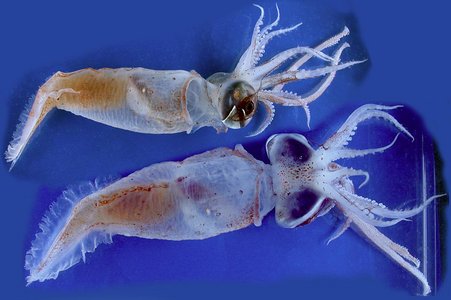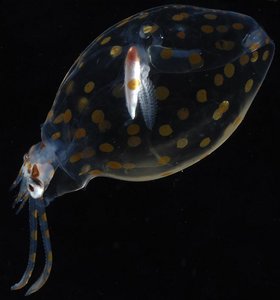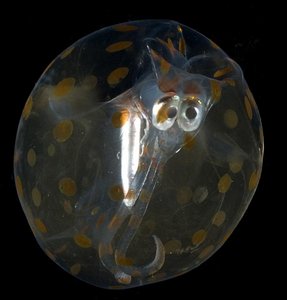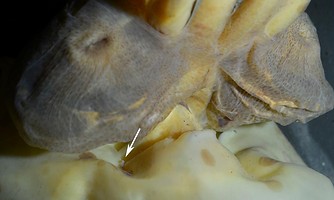Teuthowenia megalops
Richard E. Young and Katharina M. Mangold (1922-2003)Introduction
Teuthowenia megalops is a moderate sized cranchiid reaching a maximum size of over 380 mm ML (Voss, 1985). It occurs in the high North Atlantic, predominately north of 47°N in the central North Atlantic, where it seem to be one of the most abundant cranchiids (Vecchione et al., 2010).

Figure. Two superimposed images of the same specimen of T. megalops, about 140 mm ML, showing lateral attachment of the fin and the very large eyes. Top - Side view. Bottom - Dorsal view. Captured aboard the R/V G. O. SARS during the MARECO cruise to the central North Atlantic.
Characteristics
- Mantle
- Single-point tubercle, rarely absent, at each funnel-mantle fusion.
- Arms
- Arms II of males with 2 series of suckers on modified tips (sometimes appearing as 3-4 series due to crowding).
- Arms II of males with 15-19 pairs of normal suckers proximal to modified tips.
- Arms I of males without modified tips.
- Largest arm III suckers 3 times basal suckers in diameter (at least 2.0-2.8% of GL in diameter).
- Tentacles
- Largest club suckers with 19-24 teeth.
- Head
- Beaks: Descriptions can be found here: Lower beak; upper beak.
- Beaks: Descriptions can be found here: Lower beak; upper beak.
Comments
Additional details of the description of T. megalops can be found here.
Life history
The paralarval period ends when the eyes become sessile between sizes of 75 and 95 mm GL. Paralarvae have relatively large, oval and widely spaced chromatophores on the mantle. The tubercle first appears at the funnel-mantle fusion at a size between 30 and 60 mm GL (Voss, 1985).






Figure. T. megalops growth stages. Left - Two views of a paralarva photographed in a shipboard aquarium: side view, and an anterior view with the head and arms withdrawn into the mantle cavity. Also, in the latter photograph the squid had released ink into the mantle cavity. © . Right - (left to right): 11 mm ML, 29 mm ML, 60 mm ML. Drawings from Voss, 1985, p. 22.
Distribution
Vertical distribution
Lu and Clarke (1975) found the paralarval stages mostly in the upper 200 m.
With one exception at 400m, Voss (1985) found all maturing females and mature and near-mature males at depths of 1000 - 2700 m.
Geographical distribution
T. megalops occupies the productive waters of the subarctic and northern temperate Atlantic Ocean where it lies within the Northern Subpolar-Temperate faunal zone (Voss, 1985).

Geographical distribution map modified from Voss, 1985.
References
Lu, C. C. and M. R. Clarke, 1975. Vertical Distribution of Cephalopods at 40° N, 53°N and 60°N at 20° W in the North Atlantic. Journal of the Marine Biological Association of the United Kingdom, 55 (2): 143-163.
Vecchione, M. Young, R. E. and U. Piatkowski. 2010. Cephalopods of the northern Mid-Atlantic Ridge. Marine Biology Research, 6: 1, 25-52.
Voss, N. A. 1980. A generic revision of the Cranchiidae (Cephalopoda; Oegopsida). Bull. Mar. Sci. 30: 365-412.
Voss, N. A. 1985. Systematics, biology and biogeography of the cranchiid cephalopod genus Teuthowenia (Oegopsida). Bull. Mar. Sci. 36: 1-85.
Title Illustrations

| Scientific Name | Teuthowenia megalops |
|---|---|
| Reference | Voss, N. A. 1985. Systematics, biology and biogeography of the cranchiid cephalopod genus Teuthowenia (Oegopsida). Bull. Mar. Sci. 36: 1-85. |
| Sex | Female |
| Life Cycle Stage | subadult |
| View | dorsal, ventral |
| Size | 210 mm ML |
| Type | hypotype |
| Copyright | © 1985 Bulletin of Marine Science |
About This Page
Drawings from Voss (1985) printed with the Permission of the Bulletin of Marine Science.

University of Hawaii, Honolulu, HI, USA
Katharina M. Mangold (1922-2003)

Laboratoire Arago, Banyuls-Sur-Mer, France
Page copyright © 2014 and Katharina M. Mangold (1922-2003)
 Page: Tree of Life
Teuthowenia megalops .
Authored by
Richard E. Young and Katharina M. Mangold (1922-2003).
The TEXT of this page is licensed under the
Creative Commons Attribution-NonCommercial License - Version 3.0. Note that images and other media
featured on this page are each governed by their own license, and they may or may not be available
for reuse. Click on an image or a media link to access the media data window, which provides the
relevant licensing information. For the general terms and conditions of ToL material reuse and
redistribution, please see the Tree of Life Copyright
Policies.
Page: Tree of Life
Teuthowenia megalops .
Authored by
Richard E. Young and Katharina M. Mangold (1922-2003).
The TEXT of this page is licensed under the
Creative Commons Attribution-NonCommercial License - Version 3.0. Note that images and other media
featured on this page are each governed by their own license, and they may or may not be available
for reuse. Click on an image or a media link to access the media data window, which provides the
relevant licensing information. For the general terms and conditions of ToL material reuse and
redistribution, please see the Tree of Life Copyright
Policies.
- Content changed 21 January 2014
Citing this page:
Young, Richard E. and Katharina M. Mangold (1922-2003). 2014. Teuthowenia megalops . Version 21 January 2014 (under construction). http://tolweb.org/Teuthowenia_megalops/19613/2014.01.21 in The Tree of Life Web Project, http://tolweb.org/













 Go to quick links
Go to quick search
Go to navigation for this section of the ToL site
Go to detailed links for the ToL site
Go to quick links
Go to quick search
Go to navigation for this section of the ToL site
Go to detailed links for the ToL site